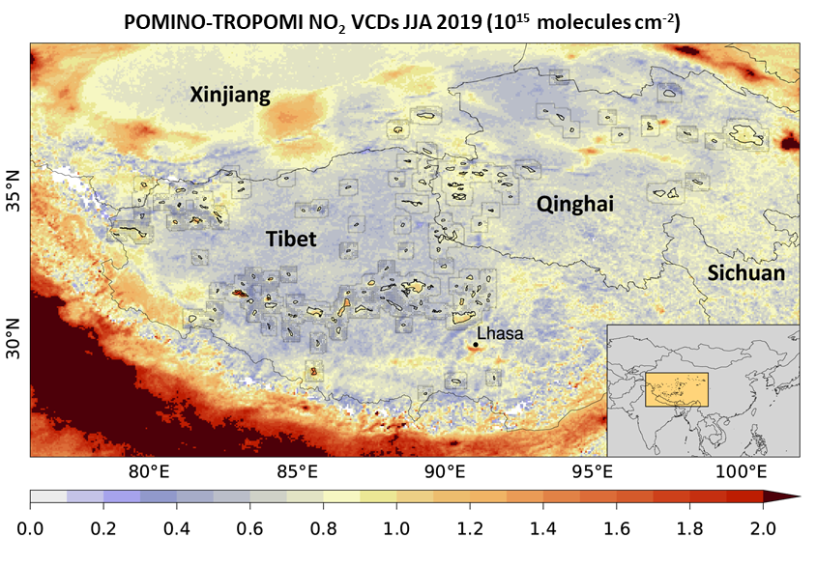NOx is an important air pollutant and a major precursor to PM2.5 and ozone, posing significant risks to human and environmental health. Tropospheric NOx is emitted mainly in the form of NO from fossil fuel combustion, biomass burning, lightning, and microbial processes, and the emitted NO undergoes fast chemical exchange with NO2 in the atmosphere. Existing NOx emission data contain large uncertainties especially at high resolutions. In particular, inland water bodies far from human activities were traditionally thought to cause trivial amounts of natural microbial-sourced NOx emissions. In part for this reason, no in-situ measurements have been conducted for such emission fluxes, and these emissions have not been accounted for in air quality models and climate models. Since the late 20th century, the rapid development of satellite remote sensing has provided an unprecedented opportunity for global monitoring of NOx pollution, worldwide NOx emission estimates, and investigation of potential unknown NOx emission sources.
For more than a decade, the research group led by Professor Jintai Lin has been devoted to high-accuracy retrieval of tropospheric NO2 vertical column densities from satellite radiance data, subsequent high-resolution NOx emission estimates, and their environmental impacts over China. About 10 years ago, the research group started to conceive a fast satellite-based high-quality NOx emission retrieval algorithm. In 2019, Hao Kong established the first version of their algorithm, named as PHLET, for NOx emission retrieval. Later in 2022, they established the second version of PHLET, which enables fast, accurate emission retrieval for a large spatial domain covering China and its surrounding areas at a high resolution (5 km). This effort has led to the highest-resolution top-down NOx emission dataset covering the entire mainland China to date. It provides an important data basis for monitoring anthropogenic and natural emission sources, exploring their climatic, environmental, and ecological effects, and supporting targeted emission control.
In this Nature Geoscience study, the research team further improved the PHLET algorithm and applied it to their satellite NO2 data product, POMINO-TROPOMI, to achieve high-resolution retrieval of NOx emissions from lakes on the Tibetan Plateau (Fig. 1). Their results show that in summer 2019, the total NOx emissions from 135 lakes larger than 50 km2 with little local human influences reached 1.89 ± 0.54 Ton N h-1, similar to the total anthropogenic emissions in the Tibetan Autonomous Region in current inventories and comparable to anthropogenic emissions from individual megacities. The 135-lake average emission intensity reached 63.4 μg N m-2 h-1, exceeding the intensity in the agricultural fields of China. Based on the spatiotemporal variations of NO2 columns and NOx emissions, together with the environmental and lake water characteristics of the plateau, the study determined that the NOx emissions are originated from natural microbial processes, such as nitrification-denitrification and anaerobic ammonia oxidation. However, current information is insufficient to concretely determine the exact microbial mechanisms. These high NOx emissions are associated with rapid warming and lake changes on the Tibetan Plateau, pointing to previously unknown feedbacks between climate change, lake ecology and nitrogen emissions.
The Tibetan Plateau, known as the “Asian Water Tower”, is of great value for the ecological environment. Along with rapid climate change, the ecological environment of the plateau is under threat. However, its remote location and unique geographical environment set a great barrier for monitoring of its ecological environment. Similar challenges exist in other remote regions worldwide. This research demonstrates the scientific and strategic importance of satellite remote sensing to detect global atmospheric environmental change, especially over remote areas such as the Tibetan Plateau.
This research is supported by the Second Tibetan Plateau Scientific Expedition and Research Program and the National Natural Science Foundation of China.


Figure 1 | High NOx emissions from lakes on the Tibetan Plateau in June-July-August 2019. Left: NOx emissions retrieved for the 135 lakes, with lake boundaries, top 10 emitting lakes, major mountain ranges and river mainstreams marked out with different colors; Right: satellite NO2 columns over the Tibetan Plateau.
References
1.Kong, H., Lin, J.-T. *, Zhang, Y.-H., Li, C.-J., Xu, C.-H., Shen, L., Liu, X., Yang, K., Su, H., and Xu, W.: High natural nitric oxide emissions from lakes on Tibetan Plateau under rapid warming, Nature Geoscience, doi:10.1038/s41561-023-01200-8, 2023
2.Kong, H., Lin, J.-T. *, Chen, L.-L., Zhang, Y.-H., Yan, Y.-Y., Liu, M.-Y., Ni, R.-J., Liu, Z., and Weng, H.-J.: Considerable unaccounted local sources of NOx emissions in China revealed from satellite, Environmental Science & Technology, 56, 7131-7142, doi:10.1021/acs.est.1c07723, 2022
3.Liu, M.-Y., Lin, J.-T. *, Kong, H., Boersma, K. F., Eskes, H., Kanaya, Y., He, Q., Tian, X., Qin, K., Xie, P., Spurr, R., Ni, R.-J., Yan, Y.-Y., Weng, H.-J., and Wang, J.-X.: A new TROPOMI product for tropospheric NO2 columns over East Asia with explicit aerosol corrections, Atmospheric Measurement Techniques, 13, 4247-4259, doi:10.5194/amt-13-4247-2020, 2020 (data available at http://www.pku-atmos-acm.org/acmProduct.php/#TROPOMI)
4.Kong, H., Lin, J.-T. *, Zhang, R.-X., Liu, M.-Y., Weng, H.-J., Ni, R.-J., Chen, L.-L., Wang, J.-X., Yan, Y.-Y., and Zhang, Q.: High-resolution (0.05°×0.05°) NOx emissions in the Yangtze River Delta inferred from OMI, Atmospheric Chemistry and Physics, 19, 12835-12856, doi:10.5194/acp-19-12835-2019, 2019
